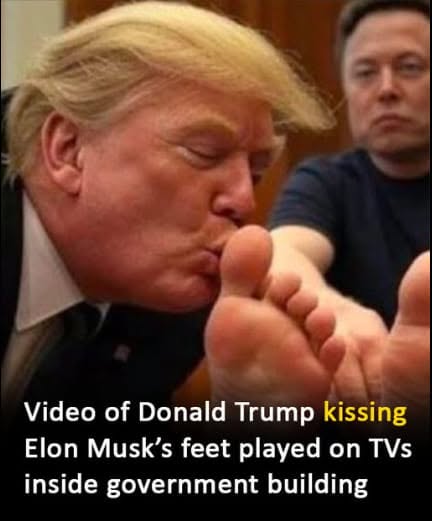AI-Generated Video of Trump Kissing Musk’s Feet Sparks Online Frenzy
In a surreal and viral moment, an AI-generated video of former President Donald Trump kneeling to kiss the feet of tech mogul Elon Musk has taken social media by storm. The video, which inexplicably appeared on television screens inside the cafeteria of the Department of Housing and Urban Development (HUD), quickly captured public attention. However, what many viewers initially believed to be a shocking political spectacle was, in reality, an artificially created piece of digital satire.
The fictional clip gained traction after Vox journalist Rachel Cohen shared it on X, where it spread like wildfire. The video, which features the exaggerated image of Trump bowing before Musk with the caption “LONG LIVE THE REAL KING,” stunned and amused viewers alike. While some found it hilarious, others questioned its implications. Regardless of where one stands, the incident highlights the growing power of AI-generated media in shaping public discourse.
Trump and Musk: A Political Alliance Under Scrutiny
The relationship between Donald Trump and Elon Musk has increasingly drawn public interest, evolving from casual admiration to a strategic alliance. Musk became one of Trump’s most vocal supporters, using his vast online influence and financial resources to back Trump’s re-election campaign. In return, Trump appointed Musk to a key government position as head of the newly-formed Department of Government Efficiency—a move that raised eyebrows given Musk’s lack of political experience.
While their partnership has focused on cutting bureaucratic inefficiencies and government spending, it has also fueled controversy. Critics question whether Musk’s involvement is driven by genuine reform efforts or a desire to expand his influence over national policy. Their collaboration continues to spark debate, with supporters praising their efforts to streamline government operations while opponents view it as a troubling concentration of power.

The Viral AI Video Incident at HUD
A surreal moment unfolded at the Department of Housing and Urban Development (HUD) when an AI-generated video of former President Donald Trump seemingly bowing in extreme reverence to Elon Musk played on cafeteria screens. The unexpected broadcast quickly became a viral sensation, with the bizarre and exaggerated nature of the video fueling widespread discussion online.
Social media users had mixed reactions—some found the video absurdly hilarious, while others were unsettled by its implications. One Twitter user summed it up by saying, “This is so funny but disgusting at the same time.” Another joked, “Bro has two left feet,” referencing an odd visual detail in the AI-generated clip. Meanwhile, others simply reacted with disbelief, with one commenter calling it “something else.”
While the video was clearly satirical, its sudden appearance in a government building raises deeper concerns about the power of AI-generated content. The fact that such a fabricated scenario could momentarily blur the line between reality and fiction underscores the growing challenge of distinguishing truth from digital manipulation in the modern era. As AI technology advances, incidents like this serve as a reminder of its potential to shape public perception—intentionally or not.

AI-Generated Content and Public Perception
The incident highlights the growing power of AI technology to produce highly convincing—yet entirely fabricated—content. As AI tools become increasingly sophisticated, distinguishing between reality and digital manipulation is becoming more difficult. The viral spread of the Trump-Musk AI video is a prime example of how easily artificial content can gain traction, even when it depicts an entirely fictional scenario.
This trend raises important ethical questions about the role of AI in shaping public perception. While this particular video was clearly satirical, it underscores the potential dangers of AI-generated media, especially when used to mislead, spread misinformation, or manipulate political narratives. As the digital landscape continues to evolve, the challenge of separating fact from fiction will only intensify—making media literacy and critical thinking more crucial than ever.

The Role of Government Efficiency and Reform
Despite the viral AI video controversy, the partnership between Trump and Musk remains centered on their shared mission to curb government waste and inefficiency. Under Musk’s leadership, the newly established Department of Government Efficiency has introduced sweeping measures aimed at slashing federal spending and restructuring government agencies. While fiscal conservatives have applauded these efforts as long-overdue reforms, critics warn of potential long-term consequences.
A cornerstone of their agenda has been reducing the size of the federal workforce, with Musk advocating for an aggressive approach to job cuts. Supporters argue that such measures are essential to addressing years of bureaucratic bloat and financial mismanagement. However, detractors caution that these drastic reductions could weaken vital government services, potentially leaving key agencies struggling to fulfill their mandates. As the debate intensifies, the true impact of these reforms remains to be seen.

Conclusion: The Impact of AI and Political Alliances
The AI-generated video of Trump and Musk serves as a striking example of how digital media and artificial intelligence are reshaping public perception. While intended as satire, the video underscores the power of AI to produce hyper-realistic content that can go viral in an instant—blurring the lines between reality and fiction. As AI technology continues to advance, media consumers must remain vigilant, questioning the authenticity of the content they encounter online.
At the same time, the political alliance between Trump and Musk remains a topic of heated debate. Their collaboration highlights the evolving relationship between political power and business influence, with Musk’s government role raising both intrigue and concern. Whether their push for government efficiency will lead to meaningful reform or unintended consequences remains uncertain. However, one thing is clear: their partnership will continue to be a focal point of public and political discourse for years to come.
What are your thoughts on the AI-generated video and the Trump-Musk collaboration? Share your perspective in the comments below!
